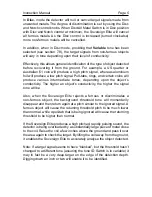
The Minelab Sovereign Elite
Page 6
2.
BBS Technology
When developing BBS technology, Minelab’s scientists first looked at
technology that was already available in the market and identified its
limitations in field use. Discussions with seasoned treasure hunters from
around the world identified a number of common problems facing
detector operators. These problems included:
•
Loss of detection depth in highly mineralised ground.
•
Inaccurate target identification beyond 5 or 6 inches.
•
Inability to detect good targets in close proximity to iron trash.
•
Erratic operation when searching salt-water beaches.
Most detectors on the market operate on a single (or dual) frequency,
ranging from 1 to 70 kHz. Although this technology has served the
industry well for years, Minelab’s scientists found that a frequency that
worked well in one area would often offer only marginal performance
when used in another location. Ground mineralisation, trash content, and
target size all had an effect on how well a detector transmitting a single
frequency would operate.
The BBS circuit automatically transmits 17 frequencies simultaneously;
a feature which is unique to Minelab metal detectors. Ranging from 1.5
to 25.5 kHz in 1.5 kHz increments, the signal received from the coil is
analysed and information is relayed to the operator via the speaker,
headphone, and meter (if attached). Through the use of its 17
frequencies, the Sovereign Elite is designed to locate and accurately
identify valuable targets in variable ground and high trash areas.
Essentially, when using a Sovereign Elite with BBS technology, it is like
swinging 17 single-frequency detectors at the same time. Because BBS
operates at a number of frequencies that no other detector does, BBS
detectors such as the Sovereign Elite can find a broad range of objects
that no other individual detector has the ability to find.
BBS technology combines Minelab’s unique multiple frequency BBS
technology with improved signal processing to give:
•
Greater detecting depth.
•
Consistent sensitivity over a wide range of targets.
•
Less interference from electromagnetic sources.







































